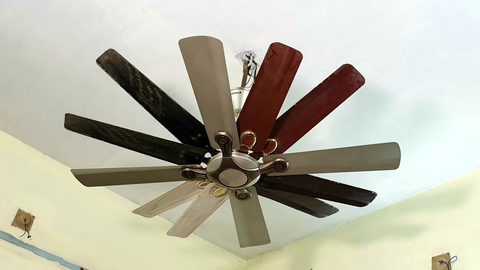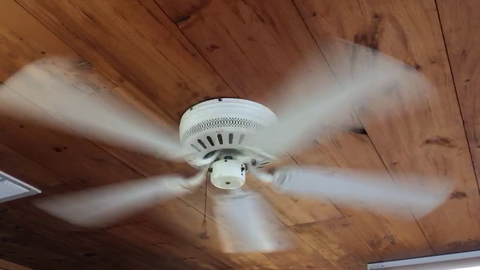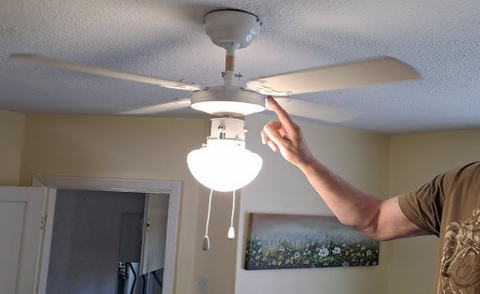
Ceiling fan
Resource: https://www.yurtforum.com
The ceiling fan is popular the world over. Used in homes, offices and commercial or industrial facilities, the fan is available in many different styles and sizes. The modern ceiling fan also comes with a variety of features, from light fixtures to remote control technology: More about these types of fans below.
What is a Ceiling Fan?
A ceiling fan is an appliance that people use to circulate air in a room or other space outdoors, with aim to provide a cooling effect — or what’s commonly called a wind chill effect. Normally suspended from a ceiling, it rotates to draw air upwards or downwards, depending on the direction of the blades.
A typical ceiling fan consists of these main components: motor, blades, and housing. The ceiling fan motor is responsible for powering the blades. These spin around to create airflow. The ceiling fan housing is the outer shell that encloses the motor. It ensures the fan looks aesthetically pleasing while also protecting it from dust and other debris.
A ceiling mounted fan may also come with lights installed. Other features include remote control technology that allows you to change the fan direction and speed — all without having to get up and manually adjust it.

Traditional ceiling fan
Resource: https://www.youtube.com/watch?v=TYwgzkixUcE
Ceiling Fan History
The history of ceiling fans traces back to the 17th century when the earliest version of the device was developed. This was a hand powered rotating frame covered with a cloth or consisting of a palm frond and moved by a cord. Its operation created a breeze, making it more comfortable for people in the warmer months.
In the late 1800s, a water powered ceiling fan was developed. This fan ran from the power of a water wheel or steam and connected with a belt system, driving several fans at once. At around the same time, an electrical version of the fan had been developed.
In 1882, the first electric ceiling fan, as we know it today, appeared on the market. As technology continued to improve, these fans became more powerful, efficient, and convenient for people living in hot climates.
Who Invented the Ceiling Fan?
The first electrically powered ceiling fan was created in 1882 by Philip Diehl who used a swing machine motor to rotate the fan blades. This marked the start of a new era in fan technology, and made it easier for people to keep cool in hot weather.
Later, Philip Diehl improved on his ceiling fan design to make it more compact, with the motor and blades all in one unit. This design would later become the first modern ceiling fan, and is still used today.
When Did Ceiling Fans Become Popular?
The early ceiling fans were solely used in factories, hotels, and similar places. It wasn't until the 1920s when they became popular in residential places. However, the air conditioner had already been invented and was becoming the cooling device of choice.
In the 1970's — and due to the energy crisis of the time — the ceiling fan, with its lower energy requirement, was to experience resurgence in popularity. Today, ceiling fans have become increasingly commonplace, mostly due to their energy efficiency and cost effectiveness.
The recent use of BLDC motors in these fans has also made them even more efficient, further enhancing their popularity. With the brushless DC motor, ceiling fans now run quitter than before, among other advantages such as longer life.

Rotating ceiling fan for room cooling
Resource: https://www.youtube.com/watch?v=JW6LdyjJPuc
How Does a Ceiling Fan Work?
After the brief history, let’s now see how a ceiling fan works. Ceiling fans work by using an electric motor to power spinning blades and create a breeze. This breeze produces what's called a “wind chill effect” (as earlier indicated), which refers to the cooling by evaporation when air passes over your skin.
- The ceiling fan blades are connected to a motor, which is connected to an electrical source by wires. When switched on, power runs through these wires and turns on the motor, spinning the blades.
- The fan can spin at different speeds according to the setting you select, allowing you to control how much air is moving.
- Most modern ceiling fans can also reverse the direction in which they rotate, allowing you to use your fan during both the winter and summer.
Ceiling fans are also often equipped with lights. A ceiling fan with lights lets you enjoy both the breeze and illumination in your space. The bulbs used in these fixtures can vary greatly, including energy-efficient LED options that save on energy costs over time.

Ceiling fan for living room
Resource: https://www.youtube.com/watch?app=desktop&v=DnU0N-m9N6Q
Uses of Ceiling Fans
Ceiling fan uses cover a range of applications, from providing ventilation and air circulation to adding style to any room. You can also install it in many different places: Bedroom ceiling fan, living room ceiling fan, kitchen ceiling fan and so on. Generally, these fans are either indoor or outdoor types.
Indoor Ceiling Fan
An indoor ceiling fan is usually installed in a living room, bedroom, or other type of interior space. You can use it to circulate air and create a cooling breeze in the summer months, as well as help warm up a room in the winter by reversing its direction. Indoor ceiling fans are usually designed with a decorative look in mind, and available in different styles to choose from.
Outdoor Ceiling Fan
An outdoor ceiling fan is designed to withstand the elements and usually installed on porches, patios, decks, and other outdoor environments. They are usually made of weather-resistant materials such as aluminum and also come equipped with waterproof blades. Outdoor ceiling fans are a great way to keep your outdoor areas cooler in hot weather.

Modern ceiling fan with lights
Resource: https://forums.njpinebarrens.com
Ceiling Fan Advantages and Disadvantages
Like any other appliance, ceiling fans have both advantages and disadvantages. The main ceiling fan advantages and disadvantages are discussed below to provide you with a better idea of how they work and what to consider before investing in one.
Ceiling Fan Advantages
One of the main advantages of ceiling fans is that they’re relatively inexpensive to purchase and install. Their higher energy efficiency means you end up saving money on electricity bills in the long run. Ceiling fans are also quite durable, with many models lasting 10 years or more with proper care and maintenance.
In terms of aesthetics, ceiling fans are built in a variety of styles to suit any home decor, and can also help enhance the look of your living spaces. Options include the rustic ceiling fan to bring a touch of the outdoors into your home, or a modern ceiling fan with sleek lines and stylish finishes.
Ceiling Fan Disadvantages
On the downside, ceiling fans can be noisy, especially if it's the less costly AC motor type. While DC ceiling motor fans run more quietly, they cost more upfront.
Ceiling-mounted fans also require regular cleaning and dusting so that the blades remain in good shape. Some people find ceiling fan air circulation to be less effective in the winter months.
To combat this issue, you may opt for a type that uses a built-in heating element to keep the air in your living space warm and cozy. A ceiling fan with heater will cost more, though, so it helps to keep that in mind when deciding which model to buy.
Conclusion
Ceiling mounted fans are an energy efficient and cost-effective way to keep your home or commercial place cool in summer. They can help you save money on electricity bills, reduce your carbon footprint, and provide a decorative touch to any living space. For the look-conscious home or business owners, there are many different styles and finishes to choose from, such as rustic, modern, or traditional.


